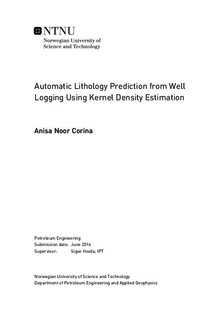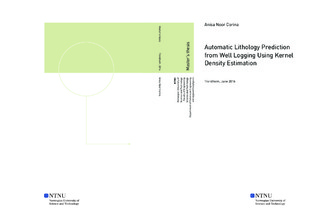| dc.description.abstract | This thesis presents an automatic real-time analysis of lithology interpretation through a method of statistical analysis: kernel probability density method. The goal of this thesis is to develop a method for interpreting and predicting lithology from the borehole geophysical data in real time. Prior to the development, the data is explored to check the data quality and the requirement of data correction. In addition, from exploratory data analysis, the data characteristics can be observed thus the best-fit classification method can be selected. The study focuses on the univariate analysis of gamma-ray data in classifying shale and non-shale lithology. In addition to univariate analysis, a preliminary study of bivariate analysis is also provided in this thesis. The bivariate analysis combines the gamma-ray and the neutron data.
Within the study, the models of probability density are constructed by using kernel estimator. The data source for the models are extracted from 3 wells in the North Sea, they are \wella, \wellb, and \wellc. The application of kernel method on gamma-ray data returns a good estimation and appropriates the non-parametric distribution of the data. There are two different types of model constructed based on the type of classification rule. The first model is constructed solely using gamma-ray data. While, the second model is constructed by combining gamma-ray data and geological description which is represented as prior probability value in the classification rule. Once the models are ready, the models are validated and tested with a set of testing data in order to assess the misclassification rate.
There are three different experiments performed based on the source of the testing data set. These experiments are executed in order to assess how precise is the model classifying lithology by using testing data from different well locations. One of the experiment tests the models with a dataset taken from the same source of the model. Meanwhile, the other two experiments test the models with a dataset taken from the different source of the models. The validation shows promising result and proves that gamma-ray is a representative variable in classifying lithology.
The evaluation techniques within this study can be applied in the practice to interpret and predict the lithology. By applying the technique, it is expected that the reading from the logging tools can be processed and the result of lithology type with the prediction can be automatically returned in the surface. The application is also beneficial to reduce the time required for lithology interpretation during drilling operation. | |

